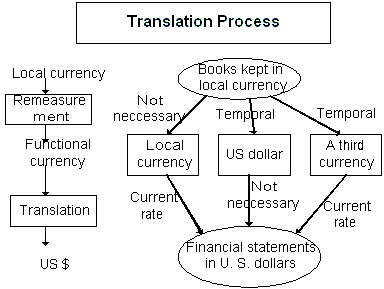- CFA Exams
- 2026 Level II
- Topic 3. Financial Statement Analysis
- Learning Module 12. Multinational Operations
- Subject 5. Remeasurement versus Translation
Why should I choose AnalystNotes?
Simply put: AnalystNotes offers the best value and the best product available to help you pass your exams.
Subject 5. Remeasurement versus Translation PDF Download
Treatment of Exchange Rate Holding Gains and LossesChange in exchange rate = Change in CTA / Net assets of foreign subsidiary 
Two methods are available under US-GAAP to translate non-US subsidiary financial statements into $US. Note the gains and losses on monetary items and the realized gains and losses on non-monetary items are identical under both methods. Thus, in terms of which holding gains / losses are recognized, the one difference between the two methods is the treatment of unrealized gains and losses on non-monetary assets and liabilities.
Under the temporal method:
- Realized and unrealized gains and losses on monetary assets / liabilities are recognized as part of the net income. The explicit disclosure of translation gain/loss is required. The accounting exposure is the net monetary asset of liability position since nonmonetary assets are not affected by changing exchange rates. The effects of volatile exchange rates are transmitted directly to reported earnings.
- Realized gains and losses on non-monetary assets /liabilities are recognized but "buried" within reported operating profits.
- Unrealized gains and losses on non-monetary assets /liabilities are not recognized.
Under the all-current method, all exchange rate holding gains and losses, whether realized or not, are recognized. However, they are reported in the income statement but flow into the cumulative translation adjustment account in stockholders' equity.
Cumulative Translation Adjustment
The use of different exchange rates during translation means the resulting financial statements will not balance. To force the statements to balance, an account called "Translation Adjustment" is debited or credited.
- Temporal method: translation adjustment is included in net income.
- All-current method:
- The cumulative translation adjustment is reported as other comprehensive income (loss) in the stockholders' equity section of the balance sheet. It is not reported in current income. In other words, currency translation adjustment does not appear "above the line." Thus, volatility due to fluctuating exchange rates does not affect reported income but is permanently accumulated in the CTA.
- When the subsidiary is ultimately sold, the cumulative translation adjustment is eliminated and affects the gain (loss) on the sale.
The change in the CTA can be used to estimate the average change in the exchange rate of the local currencies used by the firm's subsidiaries.
In general, companies with positive net assets (e.g., positive equity) will realize a positive (negative) translation adjustment from appreciation (depreciation) of the foreign currency vis-à-vis the $US.
Accounting for Foreign Operations: A Two-Step Process
- The remeasurement of the subsidiary's financial data in local current into its functional currency. For example, the functional currency of a subsidiary located in Canada is the Canada dollar. The subsidiary may have transactions denominated in other currencies such as Yen. At year-end, a balance sheet in functional currency must be prepared and each non-Canadian dollar asset and liability must be converted into the Canadian dollar. This is the remeasurement process.
- The translation of all functional currency statements into the parent (reporting) currency. Translation gains and losses arising at the translation stage do not appear in the income statement but flow directly to stockholders' equity. However, translation gains or losses resulting from the first step remain in the income statement after the translation stage.

In many cases only one step is needed. For example, if the Canadian subsidiary conducts business only in Canadian dollars (local currency = functional currency), the first step is not required.
User Contributed Comments 2
| User | Comment |
|---|---|
| danlan2 | Difference: unrealized gain/loss, non-monetary assets. |
| dblueroom | I am surprised that the current CFA institute book doesn't have something like translation g/l=net exposure*(change in exchange rate) of both flow and holding effects |

I passed! I did not get a chance to tell you before the exam - but your site was excellent. I will definitely take it next year for Level II.

Tamara Schultz
My Own Flashcard
No flashcard found. Add a private flashcard for the subject.
Add